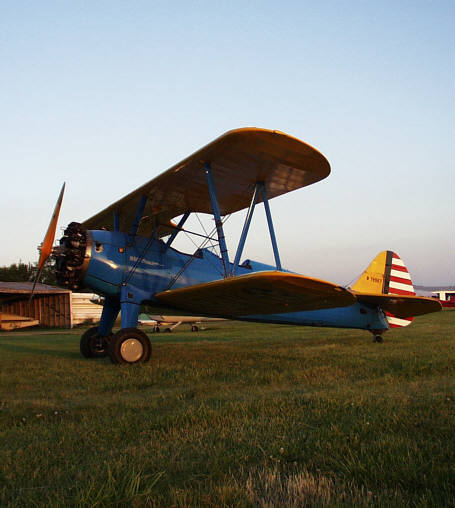 Return to
Return toAviation Answer-Man
Gateway
 Return to
Return to
Aviation Answer-Man
Gateway
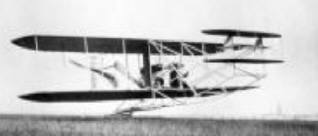 Return to
Return to
The Air Capital Story
~~~
Early General Aviation & Its Manufacturers
Copyright 2002, 2003 by Richard Harris
All Rights Reserved
Reprinted from In Flight USA
|
Note to the reader: Each month, In Flight USA, general aviation's leading pilot's tabloid, publishes another chapter of this author's history of America's great general aviation aircraft and their makers. The stories are published, more or less, in chronological order -- providing a continuous history of general aviation in America. |
The following is a condensation of the early chapters of that series, drawn mostly from the recaps of the first few months' issues of the series. This should give you a flavor for the adventures of early general aviation. ~RH |
|
|
|
|
America's most important general
aviation manufacturers of all time are little-known today. But
they started the American general-aviation industry, began
America's commercial aircraft manufacturing industry, and forever
re-shaped American military aircraft. Laird, Swallow,
and Travel Air created a nucleus of
aircraft-manufacturing genius and energy that would transform the
annals of aviation history -- all from a little city in
south-central Kansas, Wichita
, which would become the
"Air Capital of
the World,"
producing more airplanes than any other city on earth.
Cessna,
Beech, Stearman, Weaver (WACO), Vultee (later Convair
& General Dynamics), Culver, Mooney and
others, or their co-founders, would end up here, or come from
here.
|
Even giant Boeing would come to
depend upon this pivot-point of aircraft manufacturing. A Wichita
pioneer would help Northrop make
history, then revive a bankrupt Lockheed.
Many other aviation pioneers would pay their dues here, from the
inventor of the Ford Tri-Motor, Bill Stout,
to the innovative Bede (in nearby Newton)
and composite-aircraft wizard Burt Rutan, creator
of "Voyager," first plane to circle the globe non-stop without refueling, and "SpaceShipOne," the first private manned spacecraft.
Chances are, if you've flown in an airplane,
you've ridden a Wichita-influenced design. Here's how it all
began... |
Barnstorming and Pioneering: Cessna
Clyde Cessna, a Kansas farm boy in the 1880's, became a consummate handyman and mechanic, which led to a successful early career with automobiles -- first as mechanic then as super-salesman. With $7,500 he'd saved by 1911, he dove into a fascination with airplanes. Cessna set his mind to building a copy of the French Bleriot monoplanes which he'd seen earning thousands of dollars with brief aerial exhibitions.
Clyde worked for a month at the short-lived Queen's Aeroplane Co. in New York City, which built a handful of "knock-off" Bleriot fuselages. Clyde learned the craft of plane-building, and took home a fuselage, around which he built a complete working plane.
Through crashes and injuries, Cessna mastered the beast, and began flying exhibitions profitably. Never able to make the thousand-dollar flights of earlier pioneers, he nevertheless made hundreds of dollars per flight, in a day when most folks made about $600 a year. Every year, he built an improved version of the previous year's plane. By 1916, he was invited to build his personal show planes in a Wichita auto factory (for publicity), where he crafted his national record-setting 124-mph "Comet."
When the U.S. entered World War I, in 1917, the government canceled all flying exhibitions and races, and ignored Cessna's offer to build trainers and train pilots for the war, so Clyde returned to farming.
The War Changes Everything
World War I changed everything. The liesurely pace of airplane development suddenly became an immediate life-or-death matter for military forces. The governments of Europe and America dumped vast fortunes into the budding airplane industry.
In combat, Americans flew British and French planes. As the war wound on, 60-mph combat planes quickly evolved from fragile 50-horsepower, wood-framed flyers, into 100-mph steel-framed beasts with huge 200-400 horsepower engines, like the French Spad, British SE-5A and Germany's dreaded Fokker D-VII.
Before stepping into the British and French combat planes, American pilots were trained in American-made Curtiss JN-4 "Jenny," Standard J-1, or Thomas-Morse "Scout" trainers, built by a variety of companies -- mostly in the eastern U.S. Though America had never before had a successful mass-manufacturer of airplanes, it suddenly created a half-dozen -- all hastily building military trainers to prepare pilots for combat. By far, the most numerous was the Curtiss Jenny, with over 8,000 built. The Jenny's most common engine, the water-cooled "OX-5" V-8 engine, was produced in even greater quantities -- over 12,000.
When the war ended unexpectedly, the American aviation market was flooded with military surplus planes (over 5,000, mostly Jennys) and over 8,000 newly trained pilots (America only had a few hundred pilots before the war). Though this flood of civilianized aircraft and aviators would stimulate countless wild attempts at aviation money-making projects, most would fail. At the same time, the whole business of building airplanes in America collapsed. The war was over, and there were few major military contracts. As an avalanche of their own surplus products flooded civilian markets, America's military plane builders struggled or largely faded into oblivion.
But the slow, awkward, two-seat training planes they'd built -- particularly the plentiful-but-treacherous Jenny -- were of little real value. Except for big Britsh-designed/American-built deHavilland DH-4 bombers, which were used in early attempts at commercial flying and cargo/mail hauling, most planes were used in trivial ways. America needed an efficient, safe-flying, practical airplane, that could haul more than a single passenger, without the cost of a massive engine.
A Chicago-area teenaged barnstormer, named Matty Laird, returned from the war and began creating a streamlined, three-seat variation of the Jenny, with shorter, lighter, stronger wings -- and a wider front cockpit, accomodating two passengers in addition to the pilot (who sat in the back cockpit). Only 19 years old, the inventive young Laird, with these seemingly modest innovations, would soon revolutionize airplane history.
From Jenny to Swallow
In Wichita, Kansas, in 1914, the discovery of oil under the surrounding countryside led to a local oil boom, and Wichita suddenly became rich. In 1919, a gutsy Wichita oilman who'd struck it rich in the local oilfields, Jake Moellendick, gambled his small fortune on a partnership with young barnstormer "Matty" Laird and mutual friend Billy Burke to start mass-producing Laird's new biplane.
Moved to Wichita, the E.M. Laird Airplane Manufacturing Co. produced Laird's wood-framed, fabric-covered "Swallow" biplanes, becoming -- in 1920 -- the first company in America to successfully manufacture mass-produced "commercial" airplanes. Faster, and far more useful (and profitable) than the plentiful war-surplus Curtiss Jenny, the 3-seat Laird Swallow was instantly in high demand, nationwide, as fierce competition between thousands of aviators pushed up the value of an improved airplane. Soon, biplane makers everywhere would begin to widen the front cockpit to accomdate a second passenger. Many would copy the shortened wingspan and cleaner lines of the Swallow.
Walter Beech Arrives
Born January 30, 1891, in Pulaski, Tennessee, Walter Herschel Beech was a child with a passion for machinery. According to his claims, by the time he was 14, he'd built his own glider, of sorts, out of a wooden frame and bedsheets. His adolescent flight from a rooftop was brief and messy, but hardly turned Walter against the idea of airplanes. As he grew, so did his knack for fixing things mechanical. His talents led him to work in Minneapolis, Minnesota, at one of the many factories that had sprung up to build the newfangled "automobile." His job included two years traveling Europe selling cars. According to legend, for fun, in the summer of 1914, with the help of a buddy, he salvaged a wrecked Curtiss biplane, rebuilt it, and learned to fly it.
In World War I, young Walter signed up for the Army Signal Corps (then controlling American military aviation). His mechanical talents landed him at Kelly Field and Rich Field, Texas -- pilot training bases, where he bunked with another young airplane tinkerer, Eddie Stinson (who would later pioneer the enclosed-cabin airplane). Beech apparently worked his way up as mechanic, until in charge of aircraft maintenance -- then angled his way into the cockpit, becoming a flight instructor. After the war, he barnstormed briefly, but his war-surplus plane was soon lost in a fire in Arkansas City, a few miles south of Wichita, Kansas.
In 1921, jobless and dismounted, Beech migrated to Wichita, where he visited Laird's company, while Laird was out of town. Jake Moellendick, without Laird's approval, hired Beech as test pilot. But occassional test-flights weren't enough to earn his keep. Beech helped with factory labor, swept floors and cleaned preservative off war-surplus OX-5 engines before their mounting on Swallow aircraft.
Beech provided customers with demonstration rides, and took planes on sales tours. Soon he was flying Swallows to victory in America's newly-popular airplane races -- displaying the Swallow's superiority over the more-common war-surplus machines. Beech had a knack for showmanship and salesmanship, and boosted sales.
Laird Leaves, Swallow Flies
Tempermental, pushy old Jake Moellendick -- whose bull-headed drive created America's first successful commercial airplane company -- was a constant torment to everyone around him, it seems. When he couldn't get his way by guile or guff, he forced it with his fists. First he drove off friend and partner Billy Burke, and then Laird's buddy George "Buck" Weaver -- who would go back East to become a powerful competitor with his Weaver Aircraft Co. -- "WACO" (by 1928 the most prolific producer of American airplanes). Finally, even Matty Laird had had enough, and -- after building 43 Swallows -- took himself, two planes, and his company name back to Chicago. When Matty Laird got mad and left the company -- old Moellendick renamed it the Swallow Airplane Co., promoting Beech to Chief Salesman and General Manager.
Lloyd Stearman Rises
A young draftsman/production worker, Lloyd Stearman, became Chief Engineer. Only 19, Stearman was hardly a novice to airplanes. Born in rural Harper, Kansas, he'd seen his first airplane, as a teenager in 1916, when barnstormer Clyde Cessna came to town with one of his early flying machines. It must have left a big impression. Though young Stearman graduated high school, and went on to study architectural engineering, he remained fascinated with airplanes.When World War I broke out, Stearman had signed up for the Navy Flying Service, and angled a job as an airplane-rigger, mastering the intracies of fabric-covered wood-and wire biplane frames with the trained eye of an engineering student. Pushing ahead, he worked his way up into the cockpit, becoming a naval aviation cadet, but was unable to complete his training before the war ended. Stearman returned home, and began looking for work in nearby Wichita. With a partial degree in architectural engineering, his options seemed limited -- but not his imagination.
The young man talked his way into the E. M. Laird company, with his potential value as a draftsman (part of an engineer's training). But this was a tiny company, and there was more work to be done in basic aircraft assembly labor, where Lloyd started. In short order, though, he moved up the production heirarchy, and put his engineering skills to work in the service of Matty Laird, as a draftsman.
When Laird left the company, young Stearman was probably the closest thing to an engineer that the company had. Jake promoted Lloyd Stearman to Chief Engineer. While Beech wheeled and dealed, Stearman refined the Swallow into a much faster, sturdier 1924 "New Swallow" -- which sold twice as quickly as Laird's Swallow. Though the New Swallow was still built of wood and fabric, contractor Walter Burnham, added a streamlining device: the first smooth metal cowling to completely enclose the engine of an American plane. Again, the name "Swallow" (this time "New Swallow") meant pace-setting performance.
Winds of Change
War had forced changes in aircraft design, as Stearman and Beech had seen first-hand. Wooden frames, so easy to build, were obsolete in the face of new steel tubing, which offered more strength and greater longevity. Stubborn old Moellendick, however, sneered at proposals from Stearman, Beech and factory manager Bill Snook that Swallows should follow the trend. Stearman and Beech, on their own time, built a steel-frame Swallow to demonstrate the idea to Moellendick, hoping it might win his approval, when shown. Instead, when they presented it, stubborn old Jake exploded, and told them to abandon the idea, or the company.
|
|
So Beech, Stearman and Snook left Swallow. In 1925, with generous local barnstormer/farmer Clyde Cessna and merchant Walt Innes, Jr., they started Travel Air Manufacturing Co., developing the metal-framed airplane idea.
|
|
Expanding on his former New Swallow design, savvy engineer Lloyd Stearman developed the design's capacity, performance, and manufacturing simplicity. Salesman Beech developed its customer comforts and safety.
The Travel Air Model A biplane bested the other civilian planes of the day (mostly built by former Beech colleagues Laird, Weaver, Stinson and Moellendick). The Travel Air was luxurious, heavy-hauling and fast. Beech's racing victories made effective publicity for the design. He turned victories into sales -- appealing to the wealthy executive's greed for speed, status and comfort. With showmanship, salesmanship, and sensitivity to the tastes of wealthy customers, Beech became the Travel Air's driving force.
|
|
Travel Air's line expanded to include variations of the Model A, named the Model
2000, and Model 3000, then with lightweight, powerful,
reliable Wright Whirlwind radial engines, the Travel Air
Model 4000, which would sweep the industry, after sweeping
the top scores in the famous nation-circling Ford Reliability
Tour of 1926.
In an age of woefully unreliable aircraft, Travel
Airs would continue to be leaders in the industry-defining
Reliability Tour (later the "National Air Tour")
throughout the 1920s, demonstrating performance and reliability
that were the benchmarks of the industry.
Enter Olive Ann
 Beech also discovered attractive, young Olive
Ann Mellor, recently graduated from a local business college. A serious young woman from rural Kansas, with a mind for business, she reportedly had managed her own checking account from the age of 7. She became office manager, and refereed the arguments
between Beech, Stearman and Cessna. She protested, too, the
foolishness of demonstration pilots attempting to
"impress" serious, wealthy customers by terrorizing
them with acrobatic demonstration rides -- reminding her
aviator-managers that the objective of Travel Air was to sell
airplanes, not play with them.
Beech also discovered attractive, young Olive
Ann Mellor, recently graduated from a local business college. A serious young woman from rural Kansas, with a mind for business, she reportedly had managed her own checking account from the age of 7. She became office manager, and refereed the arguments
between Beech, Stearman and Cessna. She protested, too, the
foolishness of demonstration pilots attempting to
"impress" serious, wealthy customers by terrorizing
them with acrobatic demonstration rides -- reminding her
aviator-managers that the objective of Travel Air was to sell
airplanes, not play with them.
In an industry whose giants were usually great designers and salesmen -- and lousy businessmen -- businesslike Olive Ann helped Travel Air avoid the fate of other early aircraft manufacturers. She kept the books in order, carefully monitored expenses and income, and properly tended customers. While many other promising airplane companies collapsed from sloppy internal management, Olive Ann made Travel Air a model of professionalism. It was the beginning of the career of one of the most important and powerful women in aviation, who would eventually become known as "the First Lady of Aviation."
Cessna & monoplanes
In that age of fragile flying machines,
Walter Beech was partial to sturdy biplanes, whose short, stout wings and rugged joining trusswork offered strength and reliability.
However, Clyde Cessna -- long an advocate of monoplanes (his first
homebuilt was a monoplane) -- believed monoplanes (single-wing aircraft) were better.
To prove his point, he built a 5-seat enclosed-cockpit
monoplane on his own time, to show Beech the efficiency of
monoplanes. Beech noticed Cessna's plane resembled a bid
specification circulated by America's first major airline,
National Air Transport (NAT, later United Airlines).
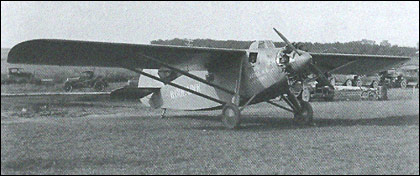 When engineer
Stearman left the company to start his own enterprise, Beech
helped Cessna finish refining the monoplane to meet NAT's
specification -- producing the Travel Air
Model 5000.
When engineer
Stearman left the company to start his own enterprise, Beech
helped Cessna finish refining the monoplane to meet NAT's
specification -- producing the Travel Air
Model 5000.
It was a quick success, especially popular for distance racing. A young mailplane pilot wanted one customized to use as the first plane to fly New-York-to-Paris, but Beech dismissed the young man's order (because of a pressing backlog of NAT orders). Charles Lindbergh was forced to settle for a Ryan monoplane, instead. Beech learned from that mistake and accepted orders from flyers wanting 5000's for the Dole First-Airplane-to-Hawaii race. Travel Airs dominated that race -- won by the Woolaroc, a modified 5000. Still, Beech was cool to Cessna's plans to advance the monoplane idea to cantilever-wings, with no external supports. So Cessna, too, left Travel Air.
Go West, young Stearman!
Young Lloyd Stearman had landed one of his Travel Airs on the Wichita stop of the transcontinental Ford Reliability Tour, when one of Wichita's prominent leaders fatally stumbled into Stearman's prop. An uproar and investigation ensued. Despite being acquitted of all charges, the tragedy devastated Stearman. At the same time, the young man felt restless in Wichita. His biplane was being eclipsed -- even if only momentarily -- by Cessna's monoplane.
Out West, Travel Air's biplanes -- which Stearman had patterned on the World War I German Fokker D-VII fighters -- were eagerly sought by Hollywood producers for war movies. Travel Air's California salesman, Fred Hoyt, persuaded young Stearman there was money in building planes in California. Stearman waved goodbye to the stress and storms of Wichita, quitting Travel Air for sunny California. Stearman Aircraft Co. opened Oct. 1, 1926, in Venice, California -- just as Hollywood's love-affair with war movies faded away... into a preoccupation with cowboy movies.
After a year's wasted effort, the despondent Stearman welcomed a call from Wichita financier Walt Innes (original president of Travel Air), who urged Lloyd to come home and re-start his new company with support from local businessmen. So Stearman returned to Wichita, to begin building big, sturdy, utilitarian biplanes for commercial work -- particularly airmail and air cargo operations.
Beech solos Travel Air
With Stearman and Cessna now having struck out on their own, Beech was alone at Travel Air. He had learned much about airplane design, but relied largely on the engineers around him -- particularly Walter Burnham and Herb Rawdon.
By 1929, air racing was the most popular spectator sport in America, and Beech looked for every opportunity to make Travel Air victorious. He had Rawdon and Burnham secretly build a Travel Air monoplane to beat the military's best in the 1929 National Air Races. Their Travel Air Model R "Mystery Ship"galloped to victory over the military's best. The famous event forced America's military to recognize the superiority of single wings, and forced their switch from biplanes to monoplanes.
|
|
As long as he was succeeding with monoplanes, Beech decided to build and sell a more streamlined monoplane than the big, draggy Model 5000. His trim, 6-seat, single-engined Model 6000 became the popular "Limousine of the Air," and was the first American plane to be manufactured with an (optional) bathroom onboard. It was the optimum personal luxury plane of its time, and it quickly became a preferred corporate transport. Some used it as an early airliner (Delta Airlines largely started with 6000s). But built in classic, rugged, reliable Travel Air style, many would survive beyond their prime to become prized bush planes. (The 6000 "City of Wichita" served as a bush & sightseeing plane, on floats, in Alaska well into the 21st Century).
Dodging the Depression
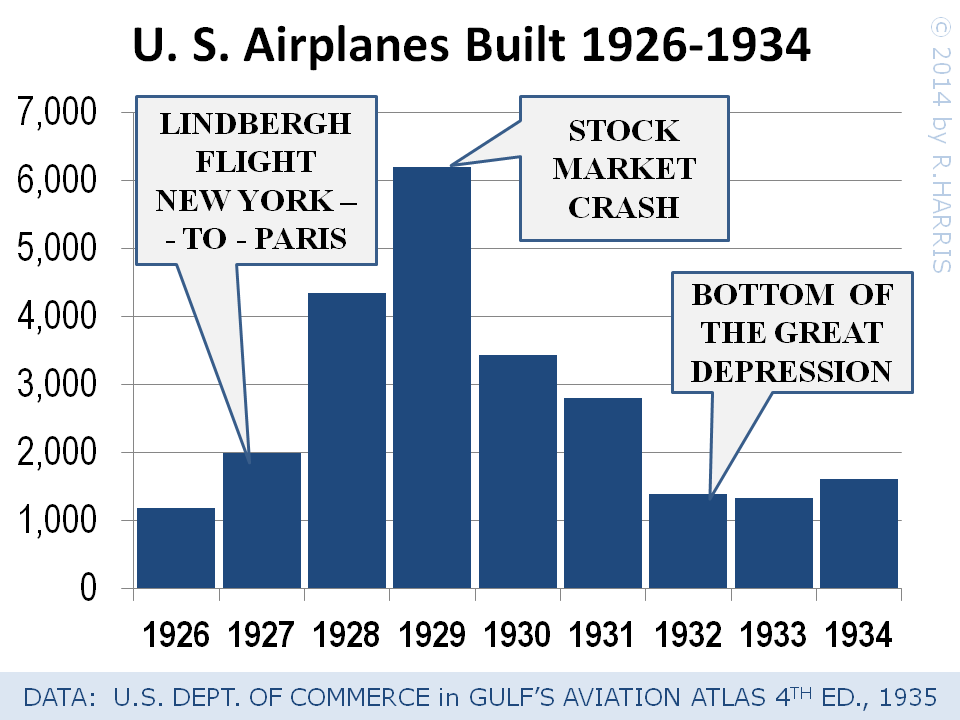
Around this time, the 1920's stock-market shenanigans peaked. Corporate consolidations swept the nation. Companies teetering on the brink of collapse sought refuge in stock-market schemes, hiding their problems in mergers and acquisitions, and in artificial income from over-hyped stocks and creative accounting. When the illusions began to unravel, investors panicked, and the stock market collapsed -- plunging the industrialized world into the deepest economic collapse of the century: The Great Depression.
Whether Beech had seen the handwriting on the wall or not, he'd spared Travel Air the disaster by selling it off, just before the crash, to its most important creditor: Curtiss-Wright Corporation -- makers of Travel Air's engines. When Curtiss-Wright moved its new Travel Air Division from Wichita to St.Louis, Walter Beech moved to New York to become the Aircraft Division president. He brought along his new bride: trusted office manager Olive Ann.
Under Curtiss-Wright, Travel Air trickled out a few cabin monoplanes and open-cockpit biplanes, and Beech presided over the development of new models with various features, to try and crack open the tight market. None was very successful.
The Staggerwing Idea
In his heart, barnstormer Beech remained a biplane man -- though he'd learned the importance of the enclosed-cabin airplane in attracting those who had enough cash to pay for his high-performance planes. His next plane would be a biplane, he decided, with the strength, maneuverability, take-off, climb and landing benefits of two short, stout biplane wings -- pulled by a monster engine for speed -- but carrying 4-5 folks in enclosed-cabin comfort.
With limited engineering sophistication and experience (important now that the government was setting engineering standards for new airplanes), Walter Beech turned to Travel Air engineer Ted Wells, who shared Beech's enthusiasm for speedy planes. Beech envisioned a civilian biplane that could outrun the military's fighters, and Wells welcomed the challenge. This would be Travel Air's 17th design -- hence, the Model 17.
|
|
The 720-hp radial Beech wanted for the plane was not yet available, but with a 420-hp radial engine, the first Model 17 was sleek and fast. Curved aluminum skins over the engine and cabin, and metal-skinned leading edges of the wing, transitioned into traditional fabric for the rest of the steel-framed plane.
Only one thin interplane strut on each side held the wings in place, with a few cross-bracing "flying wires" for support. Other wires were streamlined into the strut fairings. A narrow-airfoil wing further reduced drag. Stout landing gear assemblies were carefully enclosed in giant, streamlined wheel pants (later models would retract the gear). Early test flights showed this marvel of streamlining and power could reach just over 200mph in level flight, yet land at around 60mph. This was 1930, when America's best fighters struggled to reach 180mph.
It's most conspicuous feature was the "negative stagger" of its wings, countering the biplane tradition of putting the top wing farther forward, with the pilot looking over it from a rear cockpit. The Model 17 put the pilot ahead of the upper wing. In addition to better visibility, it put the landing gear farther forward, and permitted a streamlined, steeply-raked windshield. At one show, an announcer gave the "Staggerwing" its nickname, calling it "that negative-stagger-wing Beechcraft." The name stuck.
But the plane had problems. Landing gear was a bit narrow, inviting groundloops, and with the high angle of attack of the wings in a 3-point stance, the plane was tricky to land. Worse, engine availability forced Beech to redesign it around a 225-hp radial, at a sacrifice in speed.
There was another basic problem. Travel Air was now only a division of the huge Curtiss-Wright conglomerate, and only a minor part of Keys-Hoyt holding company which owned Curtiss-Wright and several other airplane companies. It was 1931, in the depths of the Great Depression, America's worst economic catastrophe, and money was tight. Travel Air development wasn't a high priority for big parent company Keys-Hoyt, and was under-funded accordingly.
Walter Beech saw only one solution: Strike out on his own. Returning to Wichita, he set his hopes on reviving the old Travel Air factory under a new name: Beech Aircraft Company.. The rest would be general aviation history.
EPILOGUE:
By 1929, Wichita had over a dozen companies manufacturing airplanes. With the Wichita area now clearly the leading airplane-manufacturing center in the United States, outproducing any other aviation-manufacturing community on earth, the Aeronautical Chamber of Commerce of the U.S. named Wichita the "Air Capital City" -- a title the city would claim for the rest of the century. And Wichita's early aviation alumni had spread out across the United States to kindle the fires of aviation everywhere. Here's what became of a few of them...
Jake Moellendick tried to continue Swallow, with "the brothers left behind": Matty Laird's brother Charles, and Lloyd Stearman's brother Waverly. Jake finally let them create a steel-framed Super Swallow, which became an important plane in the development of early airmail and air cargo serivce (one appears on the 1976 postage stamp commemorating the 50th anniversary of U.S. contract air mail service). Orders began pouring in for the fine airplane.
But following Charles Lindbergh's 1927 headline-grabbing trans-Atlantic victory, Jake -- the daring wildcatter, now conscious of the need for change -- gambled the Swallow company's future by putting the orders on hold and ordering his staff to quickly build a monoplane racer, the Dallas, to compete in the Dole trans-Pacific race. Alas, the Dallas was lost at sea at the start of the race (and the Travel Air Oklahoma disappeared in search of it). Along with them, sunk the fortunes of Swallow, which eventually went bankrupt. Various managers, notably Sam Bloomfield (who came from Fairchild Aircraft), helped to keep Swallow afloat into World War II -- mostly as a parts maker for other airplane companies, and as a training school for aircraft mechanics.
Jake, having alienated most of his colleagues at one time or another, it seems, died a pauper. A few remaining friends gathered the money for a proper burial. But thereafter, the bold, aggressive, stubborn man who began the success of America's commerical-airplane manufacturing industry was largely forgotten by everyone in the world, as he is to this day.
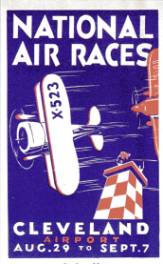 1931 National Air Races
poster, depicting the previous year's victory of a Laird Solution over the Travel Air Mystery Ship.
(Society of Air Race Historians, at www.airrace.com)
1931 National Air Races
poster, depicting the previous year's victory of a Laird Solution over the Travel Air Mystery Ship.
(Society of Air Race Historians, at www.airrace.com)
|
Matty Laird feeling abused by Moellendick (as many did), had returned to Chicago in 1923, taking his company name with him. There, sleek Laird Commericial biplanes soon led the way in air-racing, and in fast air-cargo and airmail developments in the 1920s and early 1930s.
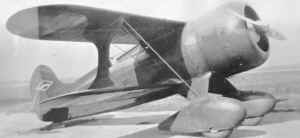 1931 Laird Super Solution
, piloted by Jimmy Doolittle, won the transcontinental Bendix race, beating a squadron of his former-employees' aircraft: Lloyd Stearman's Lockheeds and Walter Beech's Travel Air Mystery Ship.
(Society of Air Race Historians, at www.airrace.com)
1931 Laird Super Solution
, piloted by Jimmy Doolittle, won the transcontinental Bendix race, beating a squadron of his former-employees' aircraft: Lloyd Stearman's Lockheeds and Walter Beech's Travel Air Mystery Ship.
(Society of Air Race Historians, at www.airrace.com)
|
When former Laird employee Walter Beech triumphed with his Travel Air "Mystery Ship" monoplane racer -- beating the military's best biplanes in the 1929 National Air Races -- Laird responded with his Laird "Solution" biplane racers, beating the "Mystery" in the following years. Pilots "Speed" Holman and Jimmy Doolittle raced to fame at their controls, and their victories made Laird famous, too.
In later life, Laird was an active member of the Early Birds, the association of American pilots who flew before World War I.
Buck Weaver -- Laird's buddy and an established barnstorming pilot -- left the Wichita factory and returned east to Ohio, where he teamed with plane designers Clayton Brukner and Elwood "Sam" Junkin, from Battle Creek Michigan, and fellow barnstormer Charley Meyers, to create Weaver Aircraft Company -- WACO -- which would vie with competitor Travel Air to become the 1920's leader in general aviation, outlasting Travel Air, building trainers and cabin biplanes well into World War II. Their fast, capable early biplanes were the chief competitors to the biplanes of Swallow, and later Travel Air. Though Weaver would die young, from crash injuries and illness, his colleagues would preserve his memory -- in the company's initials -- for a generation.
WACO's big cabin biplanes, though slower than Travel Airs, were more affordable, and very popular in the East -- making WACO one of the cornerstones of early personal and business aviation. Several of the roomy, comfortable cabin WACO's survive to this day, and are dearly prized posssessions. But WACO became more. During World War II, WACO produced the massive invasion glider -- CG4A Hadrian -- towed by transports and released in combat areas, which landed countless platoons of troops, and their equipment, behind enemy lines during the Allies' major invasions of Nazi-occupied Europe.
WACO's biplane trainers would only be beaten in popularity by Stearman biplanes, and would serve by the hundreds to train pilots in World War II. The stout, acrobatic WACO trainers have been so long-lived and popular for airshow and sport pilots, that the company has been revived, putting the WACO Classsic YMF Super sport biplane back on the market. One of America's most popular airshow acts is Jimmy Franklin's radial-engined WACO -- with a jet engine strapped underneath.
Jerry Vultee, reportedly a Swallow craftsman, went on to create Vultee Aircraft, which later absorbed Consolidated Aircraft to become Consolidated-Vultee Aircraft, later shortened to "Convair," eventually becoming defense giant General Dynamics. Though he died young, the company which Vultee founded, in its various evolutions, created thousands of trainers and bombers during World War II, and became one of the most important aerospace and defense contractors in world history -- producing hundreds of airliners, supersonic bombers, jet fighters by the thousands (including today's F-16 Fighting Falcon), and even nuclear submarines. Recently, the company has been absorbed by rival Lockheed
Clyde Cessna, leaving biplane-builder Beech behind at Travel Air, started Cessna Aircraft Company in 1927 -- to build one of America's very first cantilever-wing monoplanes (with no external bracing, depending on the strength of its carefully-crafted, stout, internal wing structure). The result was a clean, efficient, low-drag design, that squeezed maximum speed out of minimum horsepower engines.
The 3-4 seat Cessna "A" Model -- able to drag a half-ton load at over 100mph on just 110hp -- was soon winning major races, becoming respected and popular. Cessna had little trouble getting orders for the plane. (The first one was delivered to budding flight instructor Edwin Link -- inventor of the flight simulator).
It seemed reasonable to expect that there would be plenty of customers for the acclaimed "A" Model. But a lot of money was needed "up front" to build up production capacity fast enough to meet the sudden, fleeting demand expected for the $7,000 airplanes. Clyde decided to take the risk, and forfeited controlling interest in Cessna Aircraft Co. -- in exchange for investment money to build up his company's manufacturing capacity.
Unfortunately, he did so just as the Great Depression struck, wiping out the market for airplanes. Building a larger heavier-hauling plane, his DC-6, Cessna tried to boost sales by catering to the well-fed "fat-cat" executives who were surviving the Depression -- but few were sold. (A later version, the Airmaster, would fare better.) Despite resorting to selling cheap, popular gliders, Clyde was unable to keep up sales, and was voted down by his company's new board of directors, who halted production. A shocked Clyde Cessna, out of work, turned to building custom race planes to pay his bills. His sleek C-1, C-2 and C-3 racers soon dominated the under-500-horsepower class, nationwide.
But soon Clyde's nephew, Dwane Wallace, just graduated from the new aeronautical engineering school at the local college, and his lawyer-brother Dwight, persuaded their Uncle Clyde to fight for control of his company. They helped him narrowly win a proxy fight with shareholders, in 1934, by promising that all three would work for free until the company was profitable, again. This put Clyde Cessna back in charge of his namesake, with engineer-son Eldon helping, and Dwane and Dwight managing the company on a day-to-day basis.
By 1936, after a quarter-century of struggling in aviation, Clyde lost interest, and decided to retire to his farm, quitting Cessna -- and aviation -- forever. He was 57 years old -- an old man for 1936 -- having become one of America's first aviators and one of America's first airplane manufacturers. He'd set an early speed record, and his planes had set many more. He'd survived the deadly, daredevil life of a barnstormer and the trials and tribulations of building an airplane company. A signifcant force in moving aviation to cantilever-wing monoplanes (which most planes became), he'd lived to see his independent ideas vindicated famously. The farmer-handyman was ready to go home.
Dwane Wallace took over the company, preserving his uncle's name, and built it into the collosus of general aviation. Wallace revived the company with his own "Airmaster" version of his uncle's last design. During World War II, Wallace kept Cessna busy building twin-engine T-50 Bobcat trainers (military designation AT-7, or UC-78 as a light cargo plane). The Bobcat trained nearly all of America's bomber and transport pilots in the war.
After World War II, Wallace returned struts to Cessna wings, with the Model 120/140, the first super-popular all-metal light plane. This was the real beginning of the wildly-popular, all-metal, strut-winged, single-engined Cessna line, which would eventually yield over 100,000 of these basic airplanes -- from 2-seaters to 8-seaters.
|
|
Along the way, Cessna would blast past industry leaders Beech and Piper, developing the widest range of aircraft of any manufacturer in the world -- from stunt planes to bizjets, cropdusters to combat jets -- eventually becoming the most prolific maker of aircraft in the history of the world.
Today, Cessna makes more models of light aircraft than any other company on earth -- from the 4-seat 172/Skyhawk (the world's most popular civilian plane) to the Mach .92 Citation X business jet, the world's fastest civilian airplane in production (the only faster civilian plane is the discontinued supersonic Concorde jetliner).
Walter Beech, eventually got control of the old Travel Air
factory in Wichita, and put it to work building the speedy Beech
Model 17 Staggerwing. With the genius of engineers Ted Wells and Frank Harmon, and others, Beech began redefining the state-of-the-art in modern airplanes.
Outspeeding America's fastest fighters,
the Model 17 "Staggerwing" handily won the Bendix Trophy for America's 1936
transcontinental air race -- with two women flying it -- against a cast of famous
aviators flying the fastest custom race-planes of the day.
The speedy, luxuriously appointed Staggerwing became the ultimate business aircraft of the 1930s -- something like the Learjet of its time -- and symbolized power and sophistication in ways that that no other aircraft could touch. Millionaires, movie stars, politicians, generals and diplomats would ride the Staggerwing to success. With this plane, Beech secured his claim to the legacy of Travel Air, as the producer of the ultimate in business and luxury aircraft.
Soon the
Model 18 Twin Beech was developed, bringing modern, aluminum-shell construction and twin-engine capacity to business aviation. If the Staggerwing had been the bizjet of its time, the Twin Beech was the private airliner of its time.

Beech Model 17 -- the "Staggerwing" -- in military uniform as the UC-43 Traveler
(U.S. Army Air Forces photo)
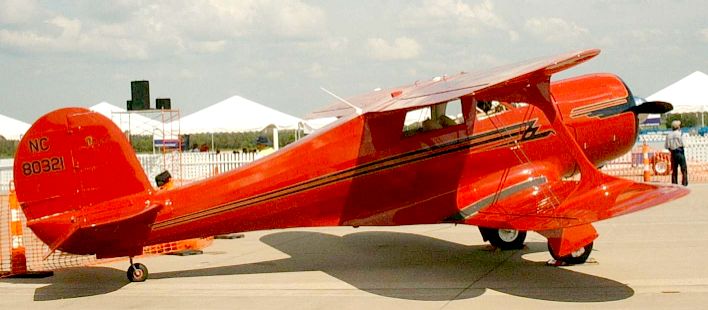
Beech Model 17 -- the "Staggerwing"
-- the definition of "going in style" in personal, single-engine aircraft of the Great Depression, and the fastest mass-produced airplane of the early 1930s, here in its last great version, the 1945 Model G17S.
Indeed, many would become commerical airliners for small, upstart "commuter" airlines, making the Beech 18 the backbone of the backyard, budget airlines. In its later years, the versatile, rugged Beech 18 would become the pre-eminent light cargo plane, ranging from the ice caps of the Arctic (on skis), to the jungles of the Amazon (on floats). The "Twin Beech" would prove so successful, that it would remain continuously in production for 33 years, setting a record (at the time) for the longest-produced civilian airplane in the history of the world (later surpassed by another Beech plane).
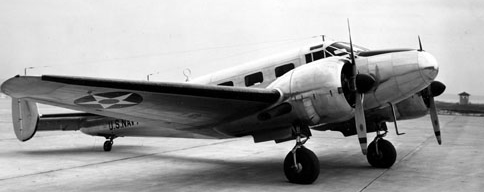
The timeless, versatile, Beech Model 18 -- the "Twin Beech"
-- one of the longest-produced airplanes in world history (FAA photo)
During World War II, the Twin Beech would be built by
the thousands, as a light transport for the military
-- with hundreds outfitted with glass bombardier's noses, small bomb racks, and machinegun turrets
as the training plane for the bombardiers, navigators and defensive gunners of America's bomber fleets.

|
|
After the war, with the development of the sleek, single-engine, 4-seat Bonanza, Beech regained dominance in business and executive aviation -- when most other plane makers were going out of business. With its retractable landing gear, lightweight aluminum-shell construction, and its distinctive "V" tail, the legendary Bonanza was, by far, the fastest and most efficient of all affordable, full-sized light planes on the market. The Bonanza would evolve into a series of other successful airplanes, including twins. A modified Bonanza, the T-34 Mentor, would become America's (and the world's) preferred military-pilot trainer for a decade, beginning a long series of modern Beech military trainers, transports and reconnaisance aircraft. After over half a century, the Bonanza (with a straight tail and 6 seats), is still manufactured today -- one of the two longest continuously-built airplane designs in the world.
|
Walter Beech also helped bring Al Mooney to Wichita -- to build his tiny, 2-seat Culver Cadet, the first truly popular retractable-geared small airplane. During World War II, thousands would be built, in secret, as target drones for the military. Reduced to the single-seat PQ-8, with remote-control equipment, they could be flown by pilots in "dry-fire" training, or by remote control for "live-fire" exercises. After the war, the all-metal Globe/Temco Swift would emulate the wooden Cadet, and Al Mooney would use his Culver experience to create his own company, Mooney Aircraft, which he eventually moved from Wichita to Kerrville, Texas -- where, today, it remains one of the world's most popular makers of high-performance light planes. |
Now aided by nephew Frank Hedrick, and her own decades of aviation
business-management experience, and a great sense of the tastes
of executive customers, Olive Ann moved the company firmly to the top
of the business aviation industry, earning Beechcraft the
repuation as "the Cadillac of light planes." In the process, Olive Ann became one of the icons of the aviation industry, known simply as "The First Lady of Aviation."
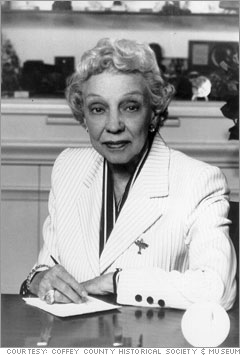 When Walter Beech died in 1950, the
board of directors chose his widow, former Travel Air office manager and Beechcraft executive Olive Ann (Mellor) Beech, to lead the company. (It wasn't her first time. During Walter's year of illness in 1940, she provided masterly leadership of the company, securing a spectacular $83,000,000 loan from the government to equip Beech better than any of its competitors could dream, and firmly setting the company on the course to permanent world dominance in executive aircraft.)
When Walter Beech died in 1950, the
board of directors chose his widow, former Travel Air office manager and Beechcraft executive Olive Ann (Mellor) Beech, to lead the company. (It wasn't her first time. During Walter's year of illness in 1940, she provided masterly leadership of the company, securing a spectacular $83,000,000 loan from the government to equip Beech better than any of its competitors could dream, and firmly setting the company on the course to permanent world dominance in executive aircraft.)
In the early 1960's, Beech Aircraft brought airliner comfort and accommodations to modern executive aircraft, with the cabin-class Queen Air -- and its turboprop deriviative, the King Air -- becoming the dominant force in business aviation for decades. Stretched turboprop versions of the Queen/King Air -- the 99 Airliner and the 1900 Airliner -- would become the leading force in the development of short-haul "commuter" airlines in the 1970's and 1980's, and they remain widely used by airlines today.
Starting in the late 1970's, and with help from designer Burt Rutan, the company began developing America's first certificated non-metal, all-composite aircraft: the canard/pusher Beech Starship, which first hit the market in the mid-1980's. In 1980, aging Olive Ann sold the company to Raytheon Corporation, which also acquired British Aerospace's Hawker Business Jets division, and moved it to Wichita, to be merged with Beech to form Raytheon Aircraft. The company was recently sold to Onex Corp, who renamed it Hawker-Beechcraft -- which continues today as one of the world's leading producers of business aircraft.
Lloyd Stearman, with his own sizeable Wichita factory, became one of the pre-eminient makers of early air-cargo and airmail planes. In a world of mostly delicate and finicky early planes, his penchant for stout, reliable designs fit well with the needs of early commercial aviation.
By 1929, Stearman Aircraft Co. would join Californian Jack Northrop (Northrop Aircraft) in the pioneering of the Northrop Alpha -- America's first modern-style, stressed-skin, all-metal airliner -- which introduced today's streamlined, lightweight, aluminum-shell aircraft design to Amercan airliners, fundamentally altering the practicality and future of aviation. Shortly thereafter, during a nationwide frenzy of corporate consolidations, Stearman-Northrop joined an aviation conglomerate, United Aircraft Co., which also acquired Boeing and Pratt & Whitney.
When a government lawsuit broke up United Aircraft's near-monopoly, Boeing was spun off with Stearman in its grasp. Stearman's Wichita plant became Boeing's biggest complex outside Washington state, and would eventually grow to become Kansas's largest employer -- building most of America's B-29 Superfortress, B-47 Stratojet and B-52 Stratofortress bombers, and major sections of all Boeing airliners, including the fuselages of Boeing's most popular airliners.
But around 1930, when Boeing execs began pushing young Stearman aside in corporate decision-making, Stearman quit and returned again to California -- to become president of a defunct airplane company being revived by a group of investors: Lockheed. Stearman would be instrumental in the company's revival, and in the design of its definitive modern plane --- the sleek, all-metal, twin-engined, twin-tailed, Lockheed Model 10 Electra -- the beginning of Lockheed's real success.
Stearman passed the engineering baton to Kelly Johnson, and Lockheed kept moving ahead, in airliners and cargo planes (from the Stearman-concieved Electra, to the C-5 Galaxy, Amerca's biggest plane), and in military aviation -- ultimately becoming the leading expert in fast-and-stealthy military aircraft. From before World War II with the P-38 Lightning to today's F-117 Nighthawk "stealth fighter," Lockheed has continued Stearman's tradition of pioneering with cutting-edge airplanes. Today, Lockheed -- now joined with Martin-Marietta, to form Lockheed-Martin -- is one of America's three largest aircraft manufacturers.
|
|
But a design Lloyd Stearman had sketched
out on a single piece of paper, left behind at Boeing-Wichita,
would become the plane most associated with his name: the Boeing
Kaydet biplane. Universally referred to as the
"Stearman" and built by the thousands upon
thousands, it trained more pilots than any other military plane
in history. Stout, stable and responsive, the rugged Stearmans survived the crashes of amateurs (as did their occupants) to develop the skills
in America's future combat pilots that would lead to victory.
Following World War II, an aging Lloyd Stearman would again build a small
company under his name, converting war-surplus Kaydets into
America's pre-eminent crop-dusters -- a role they held for two decades. As they were gradually eclipsed by modern cropdusters (particularly built by Cessna and Piper), the "obsolete" Stearman trainers blossomed by the hundreds into new lives as sport planes.
Despite being over a half a century old (the last ones were built in the mid-1940s), the
sturdy, old "Stearman" is now popular for stunt-flying
at airshows, and nearly every major airshow includes a Stearman act. Nearly three-quarters of a century after Lloyd Stearman first sketched it, and over 60 years after the last one was built, his last open-cockpit design has become -- overwhelmingly -- America's most recognized, trusted and
beloved biplane.
